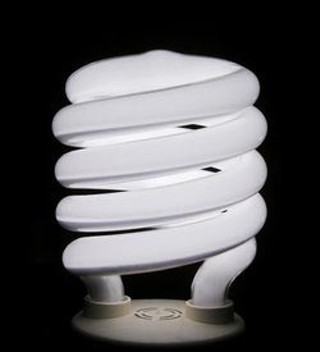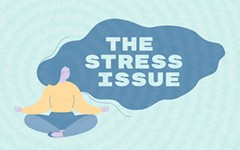Enviro-Rentalism
Saving the planet when you don't even own your own (low-flow) pot to piss in
By Nora Ankrum, Fri., March 9, 2007

The upside of global warming? You get to do fun things like buy a cool new hybrid car, install futuristic-looking solar panels on your roof, and then brag at dinner parties about how much power you're selling back to the "grid." Unfortunately, this upside requires owning property and having money – thereby excluding much of the population. In fact, about 52% of Austinites are renters, making some of the most important energy-saving activities (and city rebates) inaccessible. Moreover, rental properties are often poorly built and notorious for outdated appliances, air-conditioning units, and heating mechanisms, and landlords have little incentive to improve the energy efficiency of buildings for which they don't pay utility bills. This scenario can leave renters with a pretty big carbon footprint.
Fortunately, there's hope. First of all, according to the Statistical Abstract of the United States, the lower your income, the lower your energy use. So, pat yourself on the back for your piddling paychecks. Second, if you're planning on moving soon, you can visit AustinEnergy.com for a list of the more energy-efficient apartments in town, or see www.environmentaldirectory.info for an even more up-to-date, though less inclusive, list. Third, there are still a lot of energy-saving activities you can and should do to "shrink your footprint" – meaning that someday when you do own your own place (i.e., a stake in a sustainable urban eco-village limited-equity cooperative), you'll be way ahead of today's hybrid-happy showoffs. Because, as the city of Austin Green Building Program's Mary McLeod points out, "A five-star green home with a no-star occupant won't do you much good."
Here's just a selection of actions renters can take to make a real difference.
Compact Fluorescent Light Bulbs: You Can Be a Star
The CFL switch is essentially the poor man's solar panel or hybrid car, in that it's the closest thing you'll find to an easy fix: No lifestyle changes required. This simplicity perhaps makes it the most important action you can take as a renter to reduce your carbon footprint. It certainly explains why you can hardly open up a newspaper or turn on the radio right now without hearing about fluorescent lighting.
More expensive up front but longer-lasting, CFLs pay for themselves in savings on your energy bill (they use two-thirds less energy than incandescents and last 10 times longer, thereby saving up to $30 per bulb). Plus Austin Energy provides rebate coupons at participating locations. Take note: The rebates are only available for bulbs approved by Energy Star, a government program you hear a lot about these days because they develop and rate products that promote energy efficiency.
Home Depot sold more CFLs last year than incandescents, and Wal-Mart announced in January that it plans to sell 2 million of these miracle bulbs in the next two years. These curlicue lights are not only ubiquitous but they're overcoming their flickery cubicle-lighting stigma with new hues, shapes, and sizes that make them compatible even with lamps, dimmers, and tiny light fixtures. But the fanciest versions aren't everywhere yet. The Light Bulb Shop, 6318 Burnet Rd., has a good selection and can often special-order anything they don't have.
You can't put CFLs in the trash, as they contain mercury, but the city provides recycling at the Household Hazardous Waste Facility (2514 Business Center Dr., Tuesdays and Wednesdays, noon-7pm), as does IKEA (1 IKEA Way, Round Rock). The lack of recycling facilities is clearly a problem, but you shouldn't have to make the trek too often. For motivation, just remember: Over the lifetime of using just one bulb, you've prevented 500 pounds of greenhouse gases from entering the atmosphere.
Around the House: Little by Little
1) Until recently, most household energy went to heating and cooling, but now we have so many electronics in our homes that they account for more than half of our electricity use; even worse, a lot of that electricity is being used when these electronics are ostensibly turned "off." Your TV, for instance, has to use some amount of electricity just to sit and wait for an "on" signal from your remote control. The LED light telling you the time of day on your microwave also uses electricity. Cell phone chargers, alarm clocks, computers and their peripherals – all of these things contribute to leaking energy. But the worst offenders are the things that have become common household fixtures in just the past few years: DVRs (TiVo). All entertainment-system electronics are associated with high "phantom loads" or "vampire losses," as they're called, but cable boxes and DVRs use nearly as much energy when they're not doing anything as when they are. Assuming you don't want to go around unplugging everything all the time, there's another way to avoid all this leaking electricity. Clump as many plugs as you can onto surge protectors with on/off switches. This strategy offers a convenient way to cut the power source for several electronic devices all at once. And when it's time to buy new appliances, look for the Energy Star approval.
2) The poor man's solar screen: It's a lot harder to get rid of heat once it's gotten inside your house, which is why awnings, trees, and shutters are important. Homeowners who lack those often spring for solar screens, specially made screens that shade the window from the outside, blocking around 70% of a home's heat gain. The problem with these is the expense, not to mention that their special sizing makes it unlikely you'll be able to use them when you move. Our suggestion: Hang a bamboo shade or two outside your windows. They're cheap and easy to take with you; just remember to take them down in the winter.
3) Lower the temperature of your water heater, or ask your maintenance person to do it. Each 10-degree drop will reduce water-heating energy by 3 to 5%; also, wrap the heater in an insulating blanket if it's more than 5 years old.
4) Use your microwave: According to Austin Energy, nuking your food requires up to 70% less energy than either an electric or gas oven.
5) Check your refrigerator temperature: The fridge should be 35-38 degrees; freezers should be zero-five.
6) Watch your thermostat: Keep it at 78 degrees or higher in summer and 68 or lower in winter (you'll save 3-4% on your utility bill for every degree you go in the right direction). Even better, get your landlord to install a programmable thermostat, available for free through Austin Energy's Power Partner program. These thermostats will allow you preset temperature changes for every day of the week, allowing further savings during those hours when you're asleep or away from home.
7) Simple reminders: Turn off your lights, conserve water, change your air filters, use your ceiling fans to cool off, and heat or cool only one room if you can.
Transportation: Curb that Commute
Live close to where you work, if you can. Carpool, bike, bus, or walk when possible, and don't forget to take advantage of the Cap Metro bike racks. Got a diesel car? Use biodiesel, or better yet, get the Rhizome Collective folks (www.rhizomecollective.org) to show you how to run your car on veggie oil that you can get for free at restaurants (which is totally worthy of those dinner-party bragging rights.) Wanna wean yourself off driving without going cold turkey? Join a car-sharing group like Austin CarShare (www.austincarshare.org). Members of a similar car-sharing program in San Francisco found that they reduced their carbon-dioxide emissions by 90%.
Eating Green: Low-Carb Diet
The connection between eating and greenhouse gases isn't obvious, but it's substantial. Not only does the production of food consume a tremendous amount of energy, but its packaging, its transport, and even its disposal do as well. There are a lot of things you can do to mitigate that waste, and a lot of these things, to differing degrees, require lifestyle changes. But to some extent they merely anticipate what will increasingly become the norm as cities, where more than half of Americans reside, by necessity become more self-sustaining centers of food production.
1) Buy local, join a community garden, build mobile planter beds: The average plate of produce travels a gas-guzzling 1,284 miles to get to Austin, a sorry sacrifice when you realize how much food grows abundantly in Central Texas. Reserve your energy budget for the foods that aren't so plentiful here, and buy the rest at the farmers' market or a grocery store (like Whole Foods, Wheatsville, or even HEB) that itself buys local. Better yet, grow your own food either in your own mobile planters or at a community garden like Oasis Gardens. Several Austin-area community gardens will even deliver produce to your home. A wonderful resource for researching Central Texas' community-supported agriculture is Austin's own Sustainable Food Center, whose goal is "improving access to local, healthy, and affordable food." Check them out at www.sustainablefoodcenter.org.

2) Vermiculture (worm box!): Organic material makes up about 24% of the municipal solid waste in the U.S., which is a huge problem, not only because it causes a lot of the stench associated with landfills but because its decomposition does two very bad things: It releases organic acids that dissolve metals and help them leach down into the ground water, and it produces methane, the greenhouse gas estimated to be responsible for 15 to 17% of the global warming we will experience over the next century. If you don't have space for backyard composting, consider a worm box, which you can easily build or buy (for details see www.ci.austin.tx.us/sws/compostworms.htm). Smell-free, small, and portable, these handy worm boxes can be stored under your kitchen sink. They compost all your scraps for you, which not only keeps food out of the landfill but reduces your reliance on gas-guzzling garbage trucks. Plus, they create good soil, something cities will need more and more of as they make the transition to their bright self-sustaining futures.
3) Eat less meat: The average vegetarian diet requires half the energy consumption of the average carnivorous one.
4) Buy in bulk (and carry around those hippie canvas shopping bags, too, while you're at it): Packaging requires energy consumption both in its production (25 million families could heat their water for a year with the amount of energy used annually producing food packaging in the U.S.) and its disposal (even curbside recycling relies on fuel – if you don't buy the packaging in the first place, you won't have to waste your time figuring out how to get rid of it).
5) So, you don't cook, eh? Visit www.environmentaldirectory.info for a list of Austin restaurants who themselves buy local.
Acting Cool: Organize!
While reducing your own carbon footprint is vital, so is reducing your community's, an endeavor that requires infrastructure changes, like developing neighborhoods that are less car-reliant and more bike-friendly. Changes like these require fuel, ironically, so time is of the essence not only in terms of climate change but in terms of cost, as fuel is no more likely to stay cheap as it is to stay abundant. So get involved, or get left behind.
1) Austin Energy is one of the few utilities in the country that has an apartment-upgrade program. Organize your fellow tenants to encourage your landlord to take advantage of the many rebates available for improvements to multifamily units.
2) Going green is a lot easier when you've got friends to help you out. Join the Sierra Club, Environmental Defense, Public Citizen, Solar Austin, or other similar eco-active organizations. They'll keep you informed, let you know when your help is needed, and serve as your support network.
3) Grassroots organizing: As the Sierra Club's Jerome Collins points out, the fastest way to effect change is by galvanizing the court of public opinion.
Required reading
1) The Austin Environmental Directory: The indispensable guide to going green in Austin (a Houston version exists, too), this thorough manual covers the issues, the solutions, and the resources all in one handy booklet. Many of the statistics in this article came from the directory, which is available for free at various environmentally friendly stores around town as well as online at www.environmentaldirectory.info.
2) The Weather Makers: How Man Is Changing the Climate and What It Means for Life on Earth, by Tim Flannery: This seminal tome will teach you everything you need to know about the science behind climate change while giving you a comprehensive look at the implications of global warming and a realistic idea of what your role in reducing emissions should be. (Flannery will be in town March 20 to speak at the Paramount, along with journalist Elizabeth Kolbert, as part of the KLRU Spark Speaker Series. Visit www.klruspark.org for more on his visit and to check out the Spark blog series, which will feature various guest bloggers – Mayor Will Wynn's addition is online now – writing about global warming.)
Got something to say on the subject? Send a letter to the editor.










